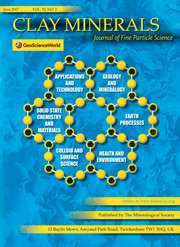Article contents
Quantitative thermal analysis of clay minerals
Published online by Cambridge University Press: 14 March 2018
Abstract
Vold's mathematical analysis of the d.t.a, curve has been applied to Murray's data on the dehydration of clays. Owing to experimental uncertainties, values for the heats of dehydration are lower than those determined by other methods. The first order law is obeyed and the activation energies of dehydration are of the same order as those derived from isothermal data; rates of dehydration are, however, higher. Furthermore, Smith's constant heat flow method has been used to determine specific heats and heats of dehydration of clays, and the effect of sample porosity upon the results has been determined. The thermal data has also been used to estimate the amount of clay mineral present. The kinetics of the dehydration process, evaluated from the apparent specific heat-temperature curves, follow a first order reaction curve. The activation energies obtained are, however, higher than those derived from other data.
- Type
- Research Article
- Information
- Copyright
- Copyright © The Mineralogical Society of Great Britain and Ireland 1955
References
- 8
- Cited by


